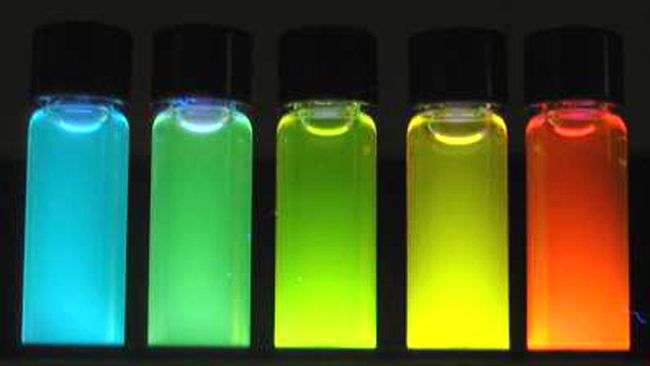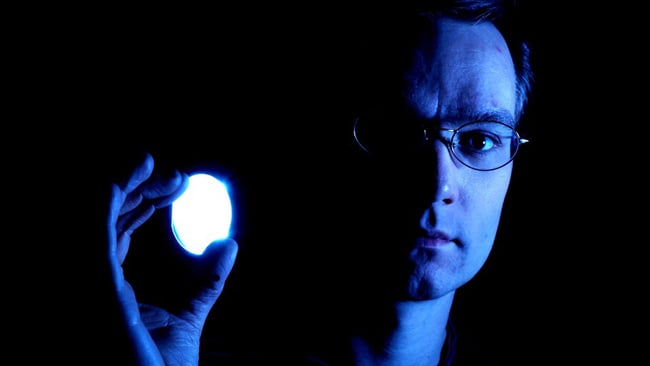
RedShark Technical Editor Phil Rhodes lifts the veil on quantum dots, and reveals why they may revolutionize lighting and display technology.
A lot of current lighting technology relies on fluorescence. Some LEDs (principally white ones, but also unusual colours such as the occasional purple, pink or lavender) rely on a blue or, more rarely, UV-emitting LED illuminating a fluorescent substance, in much the same way as a blacklight scene in a theatrical production produces glowing shapes with fluorescent paint on an otherwise blacked-out stage.
Fluorescent tubes also rely on an ultraviolet-emitting mercury arc gas discharge light driving a combination of glowing phosphors, and if we widen the definition beyond things which are strictly fluorescent, even HMI lighting works by generating UV light and converting it (with iodine) to white light with that famously convenient sun-like spectrum.
Fluoresent Explaination
The word "fluorescent" derives from the mineral fluorite, on the same basis that the word "opalescent" derives from opal. Fluorite is naturally a pale green, but often glows blue under UV light due to the presence of trace amounts of the metal europium. This, and other so-called rare earth metals (though many are not actually particularly rare), as well as things like calcium and manganese, are commonly found as an activator in the fluorescent substances used in lighting applications (and highlighter pens).

The fact that modern fluorescent tubes and LEDs work well enough for critical applications in film and TV lighting is evidence of the amount of development work that's been done in this field. Even now, though, few fluorescent tubes and even fewer LEDs reach the sort of colour-rendering performance we'd ideally like. Current equipment uses complex mixtures of phosphors, emitting various wavelengths (that is, colours). Researchers are constantly working to find new fluorescent dyes which will emit at useful wavelengths, so that things can be improved still further.
Quantum Yields & Dots
The other reason we're interested in this technology is because it's more efficient than heating a bit of wire until it glows. The limitations on the overall efficiency of a lighting system are many, but with regard to fluorescent materials, there's a statistic called 'quantum yield' which describes how many photons come out against the number that went in. Since nothing is ever 100% efficient, quantum yield is less than perfect, and dyes with a quantum yeild of under 10% would still look pretty day-glo, but some substances are better than others.
Improvements to both the colour performance and efficiency of modern lighting tools can therefore be made by finding better fluorescent substances, with more useful colours and with higher quantum efficiency. One such line of enquiry is the quantum dot, a semiconductor crystal so tiny that it behaves more like an atom, and can be fluorescent. Practical dots can be made up of a few tens of atoms, and range in size up to a few tens of nanometres. At these scales, quantum physics steps in heavily and things don't often go as we'd expect; quantum dots, in fact, behave more like individual atoms. The mechanism by which light is converted from one wavelength to another is similar; electrons are excited to a higher energy level by the short-wavelength light, then release a proportion of that energy as they fall back.
Beneficial Dots
The first and best-known quantum dot benefit is that the colour is dependent on the size of the dot, not the elements that make it up, rather as a larger loudspeaker is good at producing bass notes. Larger crystals produce longer wavelengths, and this can be precisely controlled in many fabrication processes, often by controlling the temperature, concentration and other factors as the crystals grow. This should ease the creation of phosphors targeting specific colorimetry, but there's more: extremely small quantum dots, in the tens-of-atoms range, actually produce broadband white light, which should make the production of good white LEDs a lot easier. We could not, for the record, use a blue LED to drive a white-emitting phosphor since almost all fluorescent objects emit light at a lower frequency than they absorb it; we would need a UV-emitting LED to drive a white-emitting fluorescent substance, so that the UV light would have a higher frequency than the required visible blue component.
Quantum dots are also approaching, and in some very specific circumstances, exceed existing fluorescent substances for efficiency. Last year, research company QD Vision, in Massachusetts, announced their achievement of an 18% external quantum efficiency, more than twice the preexisting record of 8% and pushing the theoretical maximum of 20% in flat panel devices. QD's work was aimed at TV and other display technologies, such as a cellphone where battery life is key, although we might hope that the principles discovered will generalise to lighting.
Sticking Points
There are a couple of caveats. Many quantum dots are made using cadmium, which is a toxic heavy metal like the mercury already used in fluorescent tubes. Cadmium is banned in many circumstances and probably best avoided in any case. Alternatives, such as zinc, made it possible for Sony to launch their first quantum dot product (the backlight in the XBR series TVs) last year, which was probably the first consumer product released that uses the technology. About the only other objection is that we're still very much in the early adopter phase, and for certain applications and in some circumstances, quantum dots currently have a considerably shorter life than the organic phosphors used in existing devices (which themselves don't last a lifetime). Since quantum dots are inorganic, however, it's reasonable to hope that once the kinks are worked out, they're likely to have considerably better longevity too.
And finally, it might not be the case that we actually build quantum-dot white LEDs for long, at least not in the current format where we use a UV emitter to power a phosphor. Quantum dots can be directly electrically driven, meaning that not only can we potentially skip the inefficiency of the monochromatic LED, we can also use them to make flat panel video displays with OLED performance and considerably-better-than-OLED lifespan, assuming all goes to plan.